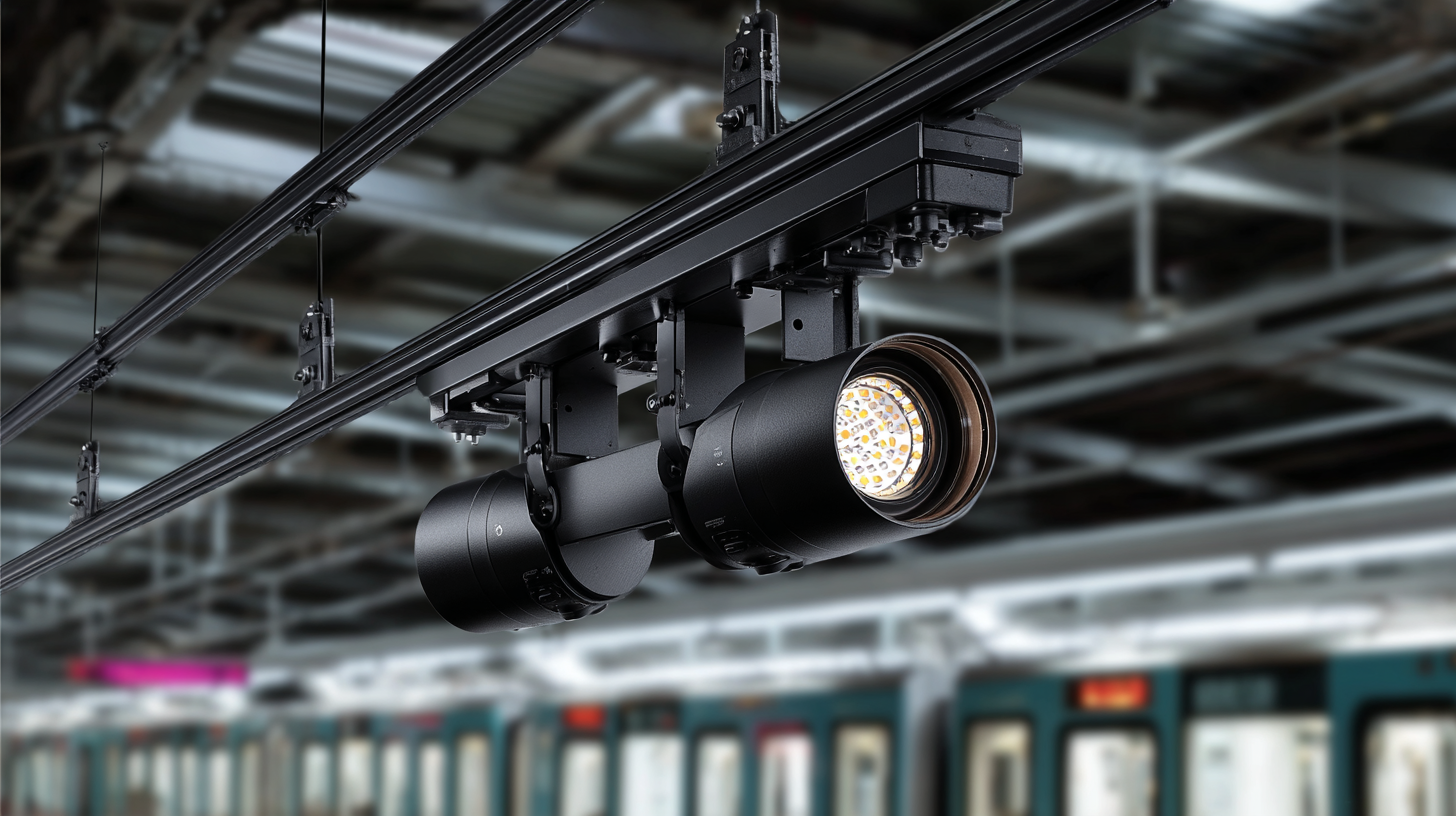2025 Global Market Outlook on LED Track Lights: A Comprehensive Guide on Selecting the Best Options
As we approach 2025, the global market for LED track lights is projected to experience substantial growth, largely driven by the increasing demand for energy-efficient lighting solutions across various sectors. According to a recent report by Allied Market Research, the LED lighting market is expected to reach USD 107.8 billion by 2027, with LED track lights playing a pivotal role in this expansion. These versatile lighting fixtures not only enhance aesthetic appeal in commercial and residential settings but also offer significant energy savings, reducing operational costs by up to 80% compared to traditional lighting options. This comprehensive guide aims to equip buyers with insights and strategies to select the best LED track light options, ensuring they make informed decisions in an evolving market landscape that prioritizes sustainability and innovation.

Understanding the Global LED Track Light Market Trends for 2025
The global LED track light market is poised for significant growth in 2025, driven by advancements in technology and increasing demand for energy-efficient lighting solutions. One of the key trends is the shift towards smart lighting systems that integrate IoT capabilities. Consumers are increasingly seeking products that offer not just aesthetic appeal but also the convenience of remote control and automation. This aligns with the growing interest in sustainability and reducing carbon footprints, as LED lighting is known for its lower energy consumption and longer lifespan compared to traditional lighting options.
Another trend shaping the market is the customization of LED track lights. As interior design evolves, customers are looking for versatile lighting solutions that can be adapted to various environments—be it commercial spaces, retail shops, or residential interiors. Manufacturers are responding by offering a wide range of styles, finishes, and beam angles that cater to diverse user preferences. This customization allows for greater design flexibility, enabling users to create unique lighting experiences that enhance the ambiance of their spaces. Overall, understanding these trends will be crucial for consumers and businesses alike as they navigate their options in the dynamic landscape of LED track lights in 2025.

Key Features to Consider When Selecting High-Quality LED Track Lights
When choosing high-quality LED track lights, several key features should be taken into account to ensure optimal performance and energy efficiency. First and foremost, consider the lumen output, which indicates the brightness of the light. A higher lumen count can enhance visibility and create a more inviting atmosphere, making it ideal for both residential and commercial spaces. Additionally, lumens can vary based on the intended usage—whether illuminating artwork, highlighting architectural features, or providing general lighting for rooms.
Another critical aspect to evaluate is the color temperature of the LED lights, measured in Kelvin (K). Warm white lights (around 2700K to 3000K) create a cozy ambiance perfect for living spaces, while cooler white lights (4000K to 5000K) are excellent for task-oriented environments such as kitchens or offices. Moreover, take into consideration the beam angle of the fixtures. Narrow beam angles can be effective for accent lighting, while wider angles are better for general illumination. Finally, ensure the track lights are compatible with dimming systems to allow for versatile lighting adjustments, catering to various moods and needs. By focusing on these essential features, you can select the best LED track lights for your space.
2025 Global Market Outlook on LED Track Lights: A Comprehensive Guide on Selecting the Best Options
| Feature | Description | Importance |
|---|---|---|
| Lumens Output | Measure of brightness; higher lumens mean brighter lights. | High |
| Color Temperature | Indicates the hue of the light emitted; measured in Kelvin (K). | Medium |
| Beam Angle | Angle at which light is spread; affects light distribution. | High |
| CRI (Color Rendering Index) | Measures how accurately colors are rendered under the light. | High |
| Dimmability | Ability to adjust light intensity; important for mood setting. | Medium |
| Energy Efficiency | Measured in lumens per watt; important for cost savings. | High |
| Lifespan | Average duration the light lasts; typically in hours. | High |
Evaluating Supplier Credentials: What to Look For in LED Track Light Providers
When evaluating LED track light providers, it is essential to consider their credentials, manufacturing quality, and commitment to sustainability. According to a recent industry report, the global LED lighting market is projected to reach $100 billion by 2025, with track lights forming a significant portion of that growth. Selecting a supplier with a proven track record in LED technology can enhance the overall performance and reliability of your lighting solutions.
One crucial aspect to examine is the supplier's quality assurance processes. A comprehensive evaluation should look into their adherence to international standards and certifications. For instance, certifications such as LM-79 and LM-80 can provide insights into the performance and longevity of track lighting products. Additionally, suppliers should demonstrate a commitment to sustainable practices, including energy efficiency and eco-friendly manufacturing processes. With light pollution becoming a pressing environmental concern, a proactive approach to sustainable lighting solutions is not just a competitive advantage but a necessary response to emerging regulations and consumer expectations.
Moreover, assessing customer feedback and case studies can reveal the supplier's capability to meet diverse project requirements and challenges. The report indicates that projects utilizing high-quality LED track lighting solutions have seen a reduction in energy consumption by over 50%, making it imperative to partner with reputable suppliers who can deliver reliable and innovative lighting systems. By focusing on these evaluation criteria, businesses can make informed decisions that will drive performance while contributing to a greener future.
Comparing Cost vs. Value: Making Informed Decisions on LED Track Lights
When it comes to selecting LED track lights, understanding the balance between cost and value is crucial. While it may be tempting to opt for cheaper options, investing in high-quality LED track lights can lead to significant long-term savings. High-efficiency models consume less energy and have longer lifespans, which can reduce replacement costs and energy bills over time.
**Tip 1:** Always check the lumen output per watt when comparing models. This metric will help you determine which lights offer the best brightness for the least energy consumption.
In addition to evaluating the upfront costs, consider the lighting quality. Look for products that offer adjustable color temperatures to create the desired ambiance in your space. Some lights can even change from warm to cool tones, allowing for versatility in different settings.
**Tip 2:** Evaluate warranties and customer support services. Higher quality brands often provide reliable service options and extended warranties, ensuring you’ll have assistance if issues arise after purchase.
By weighing these aspects carefully, you can make informed decisions that align with your budget while maximizing overall performance and satisfaction.
2025 Global Market Outlook on LED Track Lights
Sourcing Sustainable and Energy-Efficient LED Track Lighting Solutions
When considering sustainable and energy-efficient LED track lighting solutions, it's essential to prioritize both the environmental impact and the overall efficiency of the products. Choosing high-quality LED track lights not only reduces energy consumption but also offers a longer lifespan, resulting in fewer replacements and less waste in landfills. As the demand for eco-friendly lighting continues to grow, manufacturers are increasingly focused on creating products that meet these criteria while still providing excellent performance.

Tips: One crucial tip is to look for products that are Energy Star certified; this ensures that the lighting meets strict energy efficiency guidelines. Additionally, consider track lights with adjustable lumen output, allowing you to customize brightness levels according to specific needs, which can further reduce energy usage. Opting for LED lights with a high Color Rendering Index (CRI) will enhance the appearance of spaces, making colors appear more vibrant and true to life.
Investing in LED track lighting that utilizes sustainable materials can also have significant advantages. Look for lights made from recycled or recyclable materials, which contribute to a lower environmental footprint. Furthermore, exploring options with smart technology integration can allow for better control of lighting usage, enabling timers and dimmers that adjust according to the time of day or occupancy, enhancing both efficiency and convenience.
